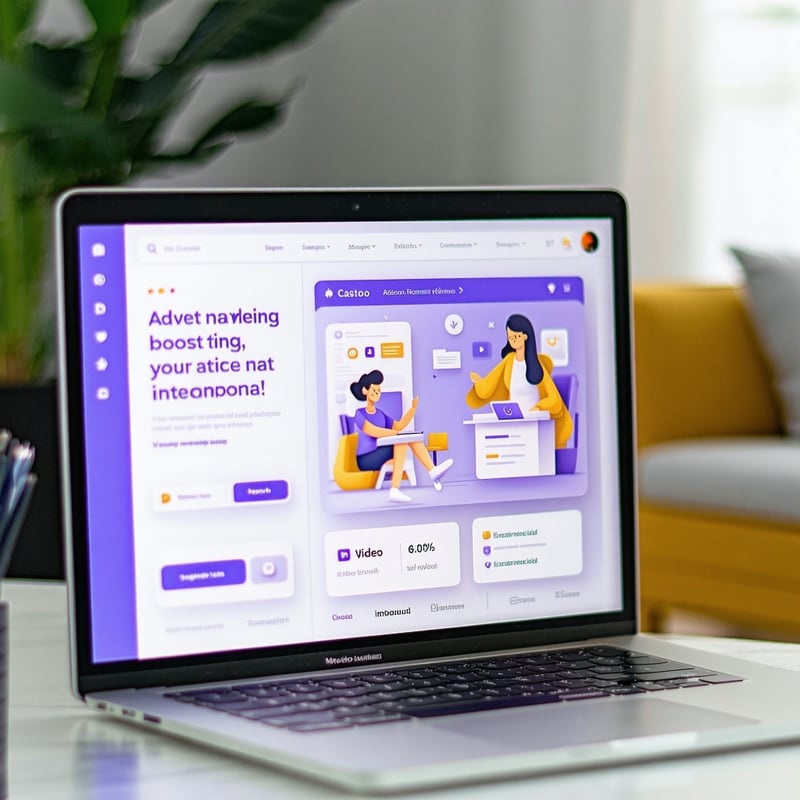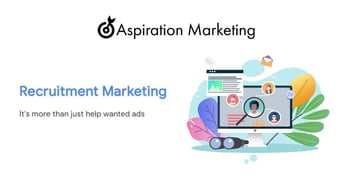A Quick Guide to Online Advertising Formats
An online advertising campaign is a must for any marketing team and is the perfect complement to an Inbound Marketing strategy. Even though marketers use the umbrella term "online advertising," it's important to remember that many formats are available for online advertisers.

This article will provide an introduction to the most common ad formats available online:
- Display ads
- Video Ads
- Banner Ads
- Carousel Ads
- Collection Ads
- Email Ads
- Search Engine Ads
- Interactive Ads
This isn't a comprehensive list of ad formats since new formats emerge every other year or can be custom-built for the right price. But these are the most prevalent and can be bought based on a Cost-Per-Click (CPC) basis or by impressions.
Display Ads
Display ads are your bread-and-butter ads. Almost all platforms (websites, apps, social media, etc.) will allow you to display ads. They're simple enough to use and set up and compelling enough that you can't ignore them. Image ads are a great starting point for any new marketer; you can't go wrong with them.
Display ads are the best choice if you don't need much text, and you can communicate all your information in one single image.
When it comes to display ads, generally, you'll have minimal space for text. Make sure you're using whatever text you have carefully, and don't forget to include the right keywords and powerful words to make the most out of your text. You can include some text in the image, but there isn't much room for textual information in display ads. Also, ensure it clicks through to the site or content you want to direct your customers.
There are many ways to go about display ads. You don't need to have a professional photographer take a fantastic picture to make a good display ad. You may not even need to use a camera at all. Sometimes something as simple as a graphic and your logo and brand name can be enough to make an image ad effective. Overloading a small image ad with tons of information can also affect your ad's effectiveness. Remember that sometimes, less is more. Ensure you get all the information you want across with as little clutter as possible. If you struggle to communicate everything in just one image, you may choose another ad format, like video.
Video Ads
Given the rise in video content across all online platforms (and especially on social media), it's no surprise that video ads have been growing alongside them. Whenever an individual looks to play a video on most online platforms, a video ad can be attached. Of course, that usually means you can only run video ads on platforms that feature video content but not exclusively. Some display ads can offer expandable ad units that can also play video. Think of these as a traditional TV commercial break while watching a video or scrolling through a website.
Video ads are best used to show your audience something in motion or share content more impactful and entertainingly. Maybe you want to show off the functionality of your product or people's reactions to it or give them a quick summary of a recent blog post you've published. If a simple image isn't enough to send the message, you should go for video ads.
Remember that videos don't need to be filmed footage (just like display ads don't need to be photographed); they can also be animated. Even though it's all video, there's a lot of variety in what you can put inside your ad unit. Ensure you're using both the visual AND the audio aspects of video ads. You won't find the option to have audio in many other ad formats, so if you have a message that needs to be heard, this is the format for you.
You want to ensure that your video ad hits all your marketing objectives precisely and effectively because video ads are the most expensive.
Like display ads, you want to ensure you're making the most of your text. The good thing about video ads is that you can work around the textual limitations by adding in a voiceover, dialogue or having text appear during your ad as it progresses. Remember that you also want to avoid overloading your video with information. Include a CTA that drives them to the relevant site on your webpage. Again, as a general rule, less is more in your ad space to maximize impact and interest.
Banner Ads
Banner ads are ads that you can run on a web page's largest real estate. Whatever space they have on their webpage or app is where banner ads appear. It's most often at the top or sides of a page, but you can also see them appearing in the center or the bottom of the page. It depends on the content that the platform displays and how it structures its website.
Banner ads aren't the most standout format. They might seem too ubiquitous and could blend into the page's background, but you shouldn't ignore them. While it would be a mistake to build your entire advertising campaign around banner ads exclusively, they should be a part of a diverse ad format mix or part of a page takeover/re-skin. The upside is that they're usually very cost-effective. The downside is that they're not outstandingly noticeable. You're getting what you're paying for.
There isn't much variety in banner ads. You're usually limited to text and visuals, but other non-traditional banner formats, such as a 'rollover to expand' banner ads, are becoming increasingly common. You could also embed a video into your banner ads; the user triggers that. If your ad is heavy on text, banner ads are usually a good choice since they allow a lot of space for text and CTAs.
Carousel Ads
Carousel ads combine multiple display or video ads into one package. They are most commonly found on social media platforms. They require the user to scroll through the different parts of the carousel to receive the whole ad experience. Social media platforms format them to match native content on their site so they appear within a user's feed seamlessly instead of being relegated to their own "advertising space." Carousel ads usually benefit from social media interactions, such as likes, comments, and shares.
This format is highly versatile. You can have up to 10 pieces of media (videos, images, or a mix of both), meaning that the amount of information you can communicate to the viewer is unmatched by other formats.
Building a carousel ad takes time and attention. Remember that it's up to the user to scroll through the carousel. That means it's up to you to get the user to scroll through. This means that each slide of the carousel should serve a specific purpose. The user's attention should be captured by the early slides (and especially the first) to make them want to learn more. This can be a special offer, a cool new feature, or a strong catchphrase.
As they progress through the carousel, the ad's information should become more in-depth. There's no point in capturing someone's attention by the 8th slide. If the first few don't hook them, they won't get through your carousel. By the time they finish going through the ad unit's images, you should want the user to know more than just general knowledge about whatever you were advertising to them and demonstrate a straightforward journey of where they should go and what they should do to learn more.
Collection Ads
Like carousel ads, collection ads are a selection of content the user can scroll through. They also appear primarily on social media (most notably Facebook). Where carousel ads are designed to allow you to relay different levels of information to a user, collection ads are more focused on displaying products. Collection ads allow you to provide direct links to the specific products you're calling out, all within one ad space.
Structuring collection ads isn't as simple as carousel ads. It's hard to know which products should come first and which depend on the user scrolling through them. Generally, it's safe to advertise your most popular products first and progressively move toward the more niche ones throughout the collection. Luckily, platforms like Facebook provide a modular algorithm for collection ads that allow for automated determination of the products' order in the ad. If you can't determine the order, just let an algorithm do it.
Email Ads
Email ads are a strong foundation for any advertising campaign, especially inbound. You send These ads/content pieces directly to the email inboxes of people on your mailing list. Email ads are incredibly effective and unique in many ways.
First, they are ads that you run yourself. Email ads aren't dependent on being run on someone else's platform. You get a mailing list and send emails; that's it. The cost of email ads is mostly within the design and production of the ad itself rather than the costs of running them. Instead of paying for ad space, you can spend that money on automation services to make managing mailing lists easier.
Email ads aren't as limited as other formats. Usually, ads must be within a small space offered by a platform, but email ads don't need to abide by those rules. As long as it can be sent in an email, it can be done in an email ad. This is why email ads are most typically image and text-based. While you don't want your ad to be too long, you can be sure that you won't feel limited in space. You have more than enough room in an email to communicate everything you want to hit all your advertising goals.
One last unique aspect of email ads is their recurring nature. To get email ads, viewers need to be on a mailing list. If they're on a mailing list, you've converted them into a lead and have a chance to change them into a prospect. This means you can create an advertising experience and a relationship beyond one ad.
Search Engine Ads
Search engine ads are typically PPC advertising that you can have displayed by search engines, depending on a user's search query. These are mostly Google ads, but that's not all search engine ads. Any platform that has its search engine has the possibility of offering search engine ads. Whether it's Google, Bing, or other platforms like Indeed or Kijiji, you can display ads through their search engines.
Search engine ads will appear at the top of the SERP, presented as "promoted" results to the users. The effectiveness of search engine ads will largely depend on the keywords associated with your ad. If your ad is relevant to very general, widely searched terms, you should look into search engine ads and use them. If your product is more niche, it may be harder to have your ad appear in many searches.
Interactive Ads
Interactive ads aren't just shown and passively consumed by the audience: they have to be interacted with. This can be a playable ad, mini-game, or, most often, a poll ad, where users give their input while being advertised and then driven to a landing page. Interactive ads are unique to online platforms. Traditional advertising media don't offer simple ways for an audience to interact with an ad.
These kinds of ads offer huge upsides paired with considerable downsides as well. Unlike versatile and adaptable image ads, interactive ads are much more niche and should be used following their niche.
The good thing about interactive ads is that they engage the audience on an unmatched level compared to any other ad format. Getting your audience to play a little mini-game before displaying your ad to them creates a much more enjoyable and positive experience than a typical ad does.
The problem with them, however, is they are much more challenging to make, as they often involve some coding paired with audio-visual design, and platforms rarely implement them. They can also be quite intrusive to a user's experience and can annoy them if designed poorly or if the user doesn't have the right plug-ins or capacity to get the full experience.
This content is also available in:
- German: Eine Kurzanleitung für Online-Werbeformate
- Spanish: Guía rápida de formatos de publicidad en línea
- French: Guide rapide des formats publicitaires en ligne
- Italian: Guida rapida ai formati pubblicitari online
- Romanian: Un ghid rapid pentru formatele de publicitate online
- Chinese: 在线广告格式快速指南

Claudia, a People Operations leader with 9+ years of experience in HR strategy, employer branding, and employee engagement, has guided human resources functions for several high-growth international companies. She played a key role in developing the global employer branding strategy at UiPath during its critical expansion phase. Claudia's expertise lies in scaling People Operations and building the essential HR frameworks that enable dynamic companies to grow effectively.







Leave a Comment